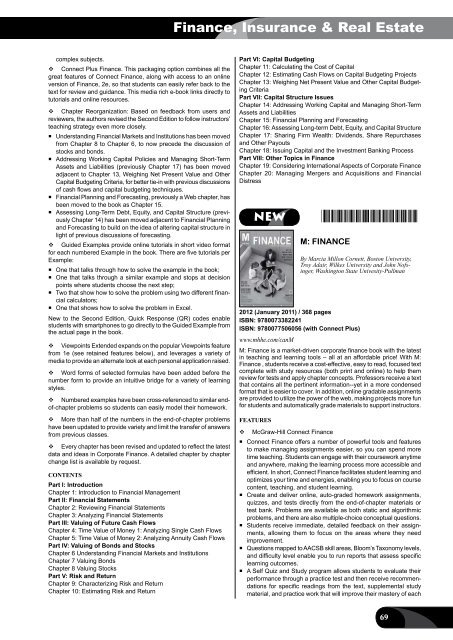Download - McGraw-Hill Books
Download - McGraw-Hill Books
Download - McGraw-Hill Books
- No tags were found...
Create successful ePaper yourself
Turn your PDF publications into a flip-book with our unique Google optimized e-Paper software.
Finance, Insurance & Real Estatecomplex subjects.Connect Plus Finance. This packaging option combines all thegreat features of Connect Finance, along with access to an onlineversion of Finance, 2e, so that students can easily refer back to thetext for review and guidance. This media rich e-book links directly totutorials and online resources.Chapter Reorganization: Based on feedback from users andreviewers, the authors revised the Second Edition to follow instructors’teaching strategy even more closely.• Understanding Financial Markets and Institutions has been movedfrom Chapter 8 to Chapter 6, to now precede the discussion ofstocks and bonds.• Addressing Working Capital Policies and Managing Short-TermAssets and Liabilities (previously Chapter 17) has been movedadjacent to Chapter 13, Weighing Net Present Value and OtherCapital Budgeting Criteria, for better tie-in with previous discussionsof cash flows and capital budgeting techniques.• Financial Planning and Forecasting, previously a Web chapter, hasbeen moved to the book as Chapter 15.• Assessing Long-Term Debt, Equity, and Capital Structure (previouslyChapter 14) has been moved adjacent to Financial Planningand Forecasting to build on the idea of altering capital structure inlight of previous discussions of forecasting.Guided Examples provide online tutorials in short video formatfor each numbered Example in the book. There are five tutorials perExample:• One that talks through how to solve the example in the book;• One that talks through a similar example and stops at decisionpoints where students choose the next step;• Two that show how to solve the problem using two different financialcalculators;• One that shows how to solve the problem in Excel.New to the Second Edition, Quick Response (QR) codes enablestudents with smartphones to go directly to the Guided Example fromthe actual page in the book.Viewpoints Extended expands on the popular Viewpoints featurefrom 1e (see retained features below), and leverages a variety ofmedia to provide an alternate look at each personal application raised.Word forms of selected formulas have been added before thenumber form to provide an intuitive bridge for a variety of learningstyles.Numbered examples have been cross-referenced to similar endof-chapterproblems so students can easily model their homework.More than half of the numbers in the end-of-chapter problemshave been updated to provide variety and limit the transfer of answersfrom previous classes.Every chapter has been revised and updated to reflect the latestdata and ideas in Corporate Finance. A detailed chapter by chapterchange list is available by request.ContentsPart I: IntroductionChapter 1: Introduction to Financial ManagementPart II: Financial StatementsChapter 2: Reviewing Financial StatementsChapter 3: Analyzing Financial StatementsPart III: Valuing of Future Cash FlowsChapter 4: Time Value of Money 1: Analyzing Single Cash FlowsChapter 5: Time Value of Money 2: Analyzing Annuity Cash FlowsPart IV: Valuing of Bonds and StocksChapter 6 Understanding Financial Markets and InstitutionsChapter 7 Valuing BondsChapter 8 Valuing StocksPart V: Risk and ReturnChapter 9: Characterizing Risk and ReturnChapter 10: Estimating Risk and ReturnPart VI: Capital BudgetingChapter 11: Calculating the Cost of CapitalChapter 12: Estimating Cash Flows on Capital Budgeting ProjectsChapter 13: Weighing Net Present Value and Other Capital BudgetingCriteriaPart VII: Capital Structure IssuesChapter 14: Addressing Working Capital and Managing Short-TermAssets and LiabilitiesChapter 15: Financial Planning and ForecastingChapter 16: Assessing Long-term Debt, Equity, and Capital StructureChapter 17: Sharing Firm Wealth: Dividends, Share Repurchasesand Other PayoutsChapter 18: Issuing Capital and the Investment Banking ProcessPart VIII: Other Topics in FinanceChapter 19: Considering International Aspects of Corporate FinanceChapter 20: Managing Mergers and Acquisitions and FinancialDistressNEW *9780073382241*M: FINANCEBy Marcia Millon Cornett, Boston University,Troy Adair, Wilkes University and John Nofsinger,Washington State Univesity-Pullman2012 (January 2011) / 368 pagesISBN: 9780073382241ISBN: 9780077506056 (with Connect Plus)www.mhhe.com/canMM: Finance is a market-driven corporate finance book with the latestin teaching and learning tools – all at an affordable price! With M:Finance , students receive a cost-effective, easy to read, focused textcomplete with study resources (both print and online) to help themreview for tests and apply chapter concepts. Professors receive a textthat contains all the pertinent information--yet in a more condensedformat that is easier to cover. In addition, online gradable assignmentsare provided to utilize the power of the web, making projects more funfor students and automatically grade materials to support instructors.Features<strong>McGraw</strong>-<strong>Hill</strong> Connect Finance• Connect Finance offers a number of powerful tools and featuresto make managing assignments easier, so you can spend moretime teaching. Students can engage with their coursework anytimeand anywhere, making the learning process more accessible andefficient. In short, Connect Finance facilitates student learning andoptimizes your time and energies, enabling you to focus on coursecontent, teaching, and student learning.• Create and deliver online, auto-graded homework assignments,quizzes, and tests directly from the end-of-chapter materials ortest bank. Problems are available as both static and algorithmicproblems, and there are also multiple-choice conceptual questions.• Students receive immediate, detailed feedback on their assignments,allowing them to focus on the areas where they needimprovement.• Questions mapped to AACSB skill areas, Bloom’s Taxonomy levels,and difficulty level enable you to run reports that assess specificlearning outcomes.• A Self Quiz and Study program allows students to evaluate theirperformance through a practice test and then receive recommendationsfor specific readings from the text, supplemental studymaterial, and practice work that will improve their mastery of each69
















